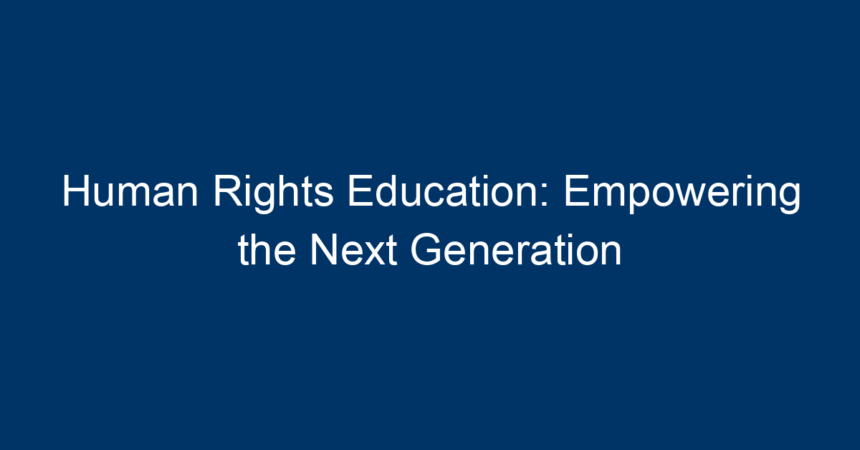In a world where injustice and inequality persist, the need for human rights education is more crucial than ever. By instilling these values in the next generation, we can cultivate informed citizens who understand their rights and responsibilities, advocate for themselves and others, and contribute to a more equitable society. This article delves into the significance of human rights education, its core components, and the role it plays in shaping future leaders.
Understanding Human Rights Education
Human rights education is a process that equips individuals with knowledge about their rights and the mechanisms available to protect them. It emphasizes the values, principles, and practices that promote human dignity and justice. By fostering an understanding of human rights, educators can empower students to engage with societal issues and encourage them to become active participants in their communities.
The Importance of Human Rights Education
1. Building Awareness
A vital aspect of human rights education is raising awareness about local and global human rights issues. Many young people are unaware of the violations that occur daily, from discrimination and poverty to violence and oppression. By integrating human rights education into the curriculum, we can help students recognize these challenges and understand their implications.
2. Promoting Critical Thinking
Human rights education encourages critical thinking by challenging students to question societal norms and beliefs. It nurtures an environment where students analyze, debate, and discuss complex issues, such as justice, equality, and freedom. This engagement fosters a generation of individuals who are not only knowledgeable but also analytical thinkers capable of making informed decisions.
3. Encouraging Empathy and Respect
At the heart of human rights education is the cultivation of empathy and respect for others. By learning about different cultures, histories, and the experiences of marginalized groups, students develop a broader perspective. This understanding fosters compassion, encouraging students to stand against injustices and advocate for those whose voices may be silenced.
Core Components of Human Rights Education
To effectively implement human rights education, several core components must be present in any educational framework.
1. Curriculum Development
The foundation of effective human rights education lies in a well-structured curriculum that incorporates human rights concepts across various subjects. This integration ensures that students encounter these themes regularly, reinforcing their importance in all aspects of society. Topics may include the history of human rights, the Universal Declaration of Human Rights, and contemporary issues such as climate change.
2. Teacher Training
Teachers play a critical role in shaping students’ understanding of human rights. Providing educators with specialized training in human rights education equips them with the skills and knowledge necessary to facilitate discussions and address sensitive topics effectively. Ongoing professional development ensures they remain informed about current events and best practices.
3. Engaging Activities
Active learning is crucial in human rights education. Incorporating hands-on activities, such as role-playing, simulations, and community service projects, allows students to experience the implications of human rights firsthand. These experiences make learning more meaningful and memorable, providing practical insights into the importance of advocacy and civic engagement.
4. Community Involvement
Building a bridge between schools and the community enhances the effectiveness of human rights education. Partnering with local organizations, non-profits, and advocacy groups can provide students with opportunities to engage in real-world issues. Workshops, guest speakers, and community service projects create a dynamic learning environment that extends education beyond the classroom.
The Role of Technology in Human Rights Education
In this digital age, technology plays an increasingly vital role in enhancing human rights education. Online resources, social media, and educational platforms provide students with access to a wealth of information about human rights issues around the globe.
1. Access to Information
The internet is a treasure trove of resources related to human rights. Websites from organizations such as Amnesty International, Human Rights Watch, and the United Nations can serve as invaluable tools for students and educators. By harnessing this information, students can research current events and engage in discussions about global human rights issues.
2. Virtual Learning Environments
As educational institutions adapt to technological advancements, virtual learning environments can be utilized to facilitate human rights education. Online courses and webinars can reach a broader audience, making it easier for students and teachers to collaborate on human rights projects and discussions.
3. Social Media Advocacy
Social media serves as a powerful platform for raising awareness about human rights issues. Encouraging students to participate in online advocacy campaigns and discussions can empower them to voice their opinions and connect with like-minded individuals globally. Additionally, social media can be a valuable tool for amplifying the messages of marginalized communities.
Challenges to Human Rights Education
While the benefits of human rights education are clear, several challenges remain.
1. Resistance from Educational Institutions
Some educational institutions may resist integrating human rights education into their curricula due to political or cultural sensitivities. Overcoming these barriers requires advocacy from educators, parents, and community members to demonstrate the importance of human rights knowledge in fostering a respectful and inclusive environment.
2. Limited Resources
Many schools lack the resources necessary to implement effective human rights education programs. Budget constraints may hinder curriculum development, teacher training, or access to educational materials. Seeking partnerships with non-profits and community organizations can help bridge these gaps.
3. Diverse Perspectives
Promoting an inclusive dialogue about human rights can be challenging, especially in increasingly polarized societies. It is essential to create spaces where students from diverse backgrounds can share their perspectives and experiences, fostering understanding and respect among peers.
Conclusion: Actionable Insights for Empowering the Next Generation
Human rights education is vital in preparing the next generation to be informed, compassionate, and active citizens. Here are some actionable insights for parents, educators, and community members:
-
Advocate for Integration: Encourage schools to include human rights education in their curricula. Engage in discussions with educators and administrators about the benefits of fostering a culture of awareness and respect.
-
Participate in Teaching: Organize workshops or sit on panels to share insights about human rights issues. By being involved, you can provide valuable resources and support for educators.
-
Leverage Technology: Use digital tools and social media to spread awareness about human rights issues. Encourage students to explore online resources and participate in virtual discussions.
-
Engage in Community Projects: Invest in local initiatives that promote human rights. Community involvement not only benefits those in need but also provides students with hands-on experiences.
- Foster Conversations: Create spaces at home and in schools for discussing human rights issues. Encourage open dialogue about current events and their implications on society.
By embracing human rights education, we can empower the next generation to be advocates for justice and equality, creating a more informed and empathetic society. Together, let’s equip young people with the knowledge and skills necessary to bring about positive change in the world.




